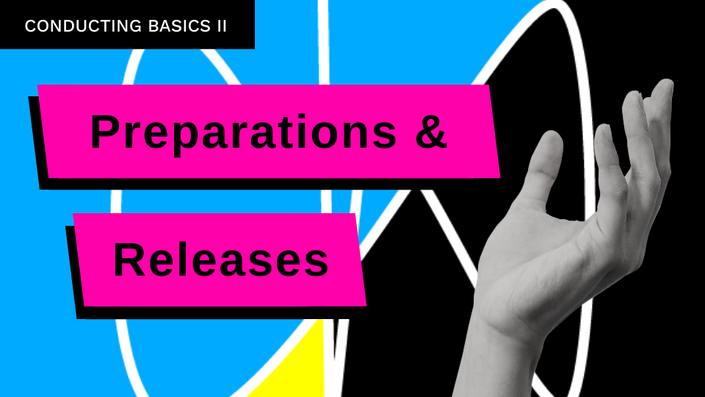
Conducting Basics II - Preparations & Releases
Learn the basics of starting & stopping the sound
Review and refine your fundamentals.
- Start the sound clearly without messy or missed entries
- Help your ensemble breathe together and move together
- Connect and sensitise the ensemble to your gestures
- Know when to use or not use a double preparation
- Understand the principles for starting the sound in any character, tempo, dynamic and style
- Create a variety of different sounding releases - from abrupt to tapered
- Negotiate all types of pauses with complete, partial or no break in the sound
Become a better conductor.
How do you end a pause with a lift then continue on again?
Wish you could go back in time and watch those lessons as often as you want? With lifetime access to the course, you can watch the instructional videos as many times as you want, whenever you want. You can even rewind to just watch one single gesture.
Solve real-world problems immediately.
- Messy entries or releases?
- Ensemble not breathing or moving together?
- Someone hanging over at the end of the music?
Using the Ensemble Issues Index you can easily find the relevant lesson. You can go to any lesson at any time, so you can get what you need, when you need it.
Solve your nagging issues.
Do you have musical issues that constantly crop up in your rehearsals, time and time again?
Find the conducting solutions to common musical problems.
Many common musical issues can be solved with tweaks to your conducting gestures. The result? Better ensembles, new positive habits, and more efficient rehearsals.
Be more expressive.
We often begin as conductors like musicians - focussing on the nuts and bolts of technique, without having anything musical to say. For a while, this works as we focus on how to wave our stick. But with more experience on the podium, we come up with ideas and emotions we want to express, but we no longer remember the tools and techniques needed to share them.
In the course, you'll discover the basic processes and principles behind each gesture and how it will influence the ensemble's sound. So once you know what sound you want, you'll be equipped with exactly how to show it in your conducting.
More time making music, less time talking.
Great conducting is great rehearsing.
Conducting Basics helps you not only learn basic techniques, but know how to critique your own conducting and practice your new skills.
Your Instructor

In demand internationally as a clinician, guest conductor and lecturer, Ingrid is renowned for her ability to lead ensembles to deeper, meaningful musical performances. She has spent the last 15 years leading transformative musical experiences for musicians in schools, universities and community ensembles.
Committed to conductor education, she has served as State President of the Australian Band & Orchestra Directors' Association (ABODA), taught conducting to graduate students at the University of Melbourne, and continues provides individual tuition to hundreds of teachers through private tuition, festivals and competitions across Australia.
